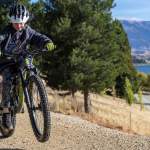
Cycle Trail Etiquette
words Chris Foggin & Geoff Marks, photos by Geoff Marks
Foggie is a fanatic... but in a good way.
He’s fanatical about cycling and getting more people riding bikes.
Based in Clyde, Chris “Foggie” Foggin is a bike tour guide, ambassador, educator, advocate, and burgeoning social media influencer. Whether it’s a road bike, gravel bike, e-bike, or mountain bike, if it has two wheels and pedals, then Foggie is into it!
So, who better to offer some tips on good biking etiquette to help keep us all on track this summer?
Trail Hub sat down with Foggie over a coffee* for his thoughts and advice.
“I ride every week somewhere in our region and love the feel, the climate, the landscapes, and the cycling variety Central Otago offers”, says Chris.
“For the most part, interactions on the trail network are friendly, positive, and well mannered. But, with the growth of cycling, cycle tourism and use of the expanding trail network across Central Otago, it’s timely to remind everyone of good trail cycling etiquette so we avoid any unnecessary conflict”.
“Showing courtesy to other trail users, as well as the trail itself is, well, just good manners”, believes Foggie.
*[We reckon that Rule No1 of Bike Etiquette should be all about coffee… #NoCoffeeNoRide].
BEING GOOD BIKE CITIZENS WHEN RIDING ON PUBLIC TRAILS
- Be prepared - you should know your equipment, your ability, and the area in which you are riding. Know what to expect.
- Always wear a properly fitted helmet and appropriate gear.
- Make sure you stay in control, therefore safely avoiding others and keeping yourself intact. Inattention even for a second can cause problems.
- It’s good practice to give way to walkers, runners or horse riders. Often walkers or runners will give way to cyclists.
- Anticipate other trail users around corners or in blind spots.
- Acknowledge fellow trail users. A wave, smile or quick ‘g’day’ are usually well received.
- Use a verbal greeting (or bell if you have one) when approaching others. Most negative feedback from walkers or other riders on shared-use tracks relates to being surprised by bikers approaching without warning.
- A polite call - “coming right/left” or “on your right/left” should warn other users when you ride up from behind. Then “thank you” as you pass.
- Try to be consistent and pass on the right. This is dependent on the trail environment.
- Ride shared-use tracks in small groups. A ‘bike-train’ with a dozen riders displaces other users. 6-8, or less, is a better number. Maybe consider breaking larger groups into smaller pods along the same route.
- When riding with others, in a line on a narrow trail, try to allow approx. 4 to 5m between each rider. This will allow more reaction time to cope with hazards or changes on the trail.
- If you are riding with others remember to point out hazards to the riders behind.
- When approaching an oncoming rider, particularly on narrower trails, back your speed off and try to keep left. I often see riders who don’t have full control, or are less confident with their bike handling, holding the centre of the track. A tip here is to look passed the oncoming rider to the point where you want to be – looking directly at the rider may cause you to ride towards them (REMEMBER: ‘where your eyes go the bike goes’).
- There are no hard and fast rules for giving way on a hill section; however, a rider coming up hill will have a harder time starting again, so it’s usual courtesy that you give way to riders coming up the hill.
- On wider trails or tracks try to stay left, particularly if you know the trail is well used.
- Earn the respect of others by setting a good example of environmentally sound and socially responsible off-road cycling.

Preparing for the Lake Dunstan Trail
Since opening in 2021, the Lake Dunstan Trail has become one of the most popular trails in New Zealand.
However, riders should be aware that parts of the trail are in remote terrain with some challenging grade 3 sections. These sections are only suitable for confident, experienced cyclists and are not recommended for most children.
To understand what to expect and to prepare for your ride click below.
RESPECTING THE RULES
- Only ride designated bike and/or shared-use tracks; stay off closed tracks – including those that are seasonally closed for lambing or to protect the surface or minimise conflict with other users. Land managers are generally reasonable so talk with them about issues or ideas you may have.
- On private land obtain permission from landowners before you set out.
- Stick to speed limits – e.g. The Otago Central Rail Trail has a limit of 25kmph.
- Be prepared - take food, water, tools, first aid and appropriate clothes. Plan for the unexpected - a change in the weather, an accident or getting lost and being late.

RESPECTING THE TRAIL & ENVIRONMENT
- Be sensitive to the dirt beneath your wheels and practice low-impact cycling.
- Avoid skidding, cutting corners or making new lines. Skidding creates water channels and causes erosion. Use both brakes to slow down without skidding as you approach a corner. Cutting corners is ‘cheating’ and damages fragile ecosystems.
- Hard or unnecessary braking on heavy bikes, such as Ebikes, can also cause corrugations – therefore learn how to modulate or ‘feather’ your brakes accordingly.
- Avoid riding some trails in the mud and rain. However, this is track dependent - both bikes and walkers damage soft, wet tracks.
- Clean your bike to prevent spreading weeds like gorse and didymo.
- Take rubbish home – like banana skins, old tubes and snack wrappers. Rubbish in the outdoors detracts from everyone’s experience.

Read and obey all trail signage. It's there for you and the safety of others.
RESPECTING PUBLIC ACCESS EASEMENTS
- Some trails or bike routes travel along public access easements through private land. All easements and tracks should be marked.
- Stay on the public easement track.
- You should leave gates as you find them.
- Never scare animals. All animals are startled by an unannounced approach, a sudden movement, or a loud noise can scatter cattle and sheep or disturb wildlife. This can be dangerous for you, others, and the animals, so give animals extra room and time to adjust to you.
As we finish our coffees, Foggie is keen to point out that, “all of the above points are not intended to overregulate our cycling freedom, but hopefully they’ll increase awareness and understanding, and help maintain a friendly and pleasant place for us all to ride”.
“Being a good bike citizen and doing your bit to keep cycling on our trails attractive to others is always appreciated, and remember … always enjoy your rides”, concludes Foggie.
….and don’t forget the coffee!

For more great cycling insights, you can follow Foggie and Co. on the Recreational Riders Facebook page, which is a forum to engage with recreational cyclists across New Zealand. The group shares stories, training tips, road safety advice, places to ride, showcases new trail development, advice on buying bikes & gear, promotes ride groups and generally shares a love of cycling.
Related Stories
-

Otago Central Rail Trail Pub Guide
A guide to the pubs along the Otago Central Rail Trail
Read more about Otago Central Rail Trail Pub Guide -

Best Bakeries in Otago
From cinnamon scrolls to cheese rolls - a guide to the best trailside bakeries in Otago.
Read more about Best Bakeries in Otago -

25 Years On Track
The old and the new - celebrating 25 years of the Otago Central Rail Trail
Read more about 25 Years On Track -

Neat Trail Places
An insider's guide to the neatest places along Central Otago's bike trails.
Read more about Neat Trail Places -

Clutha Gold Trail Beginners Guide
A beginners guide to the Clutha Gold Trail
Read more about Clutha Gold Trail Beginners Guide -

Beginners Guide to Queenstown Trails
A beginner's guide to biking the Queenstown Trails
Read more about Beginners Guide to Queenstown Trails -

Beginners Guide to the Otago Central Rail Trail
A beginner's guide to the Otago Central Rail Trail
Read more about Beginners Guide to the Otago Central Rail Trail -

Don't just ride - play bike!
If we play sports, then why don't we "play bike"?
Read more about Don't just ride - play bike!










